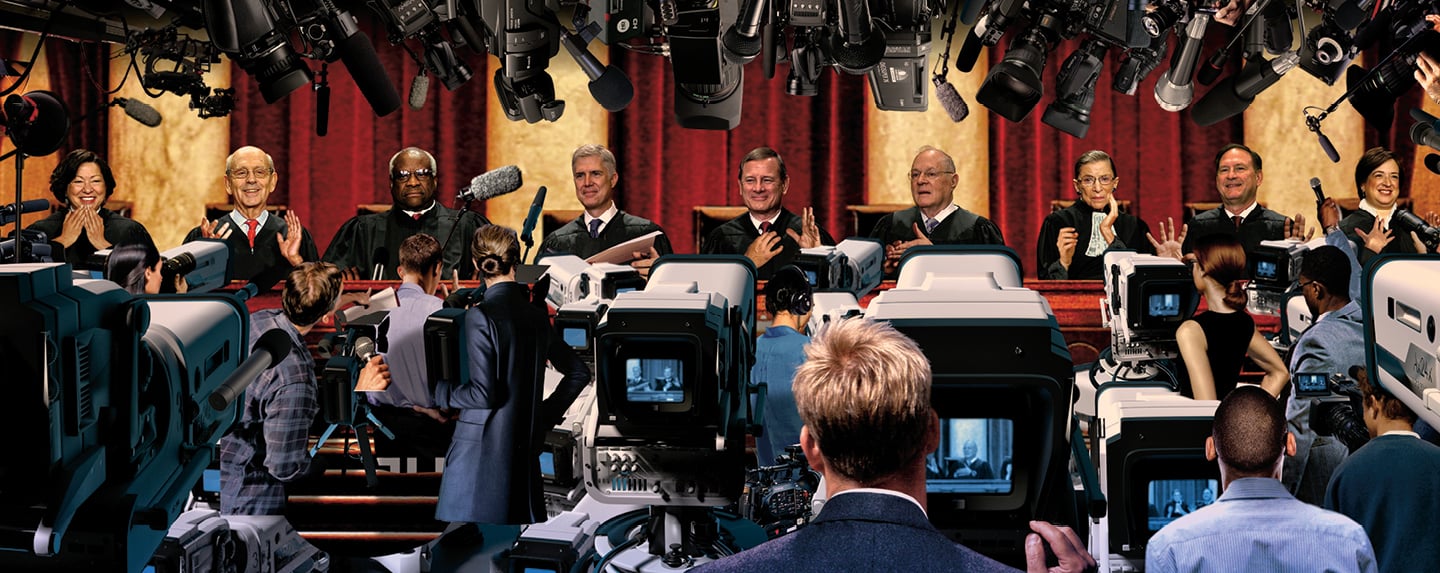
Subscriber Only Resources
Access this article and hundreds more like it with a subscription to The New York TImes Upfront magazine.

Illustration by Eddie Guy. Tim Sloan/AFP/Getty Images (Supreme Court Justices); Alex Wong/Getty Images (Justices Gorsuch, Roberts, Kennedy, Alito)
Article Options Text-to-Speech See Student ViewShould the Supreme Court Be Televised?
Television cameras have followed the president around for as long as there’s been TV news. And C-SPAN has provided live coverage of Congress since 1979. But the third branch of the federal government, the Supreme Court, remains a camera-free zone. In fact, the Court doesn’t even allow still photographs to be taken during oral arguments, when the Court’s nine justices hear cases and question lawyers representing both sides. The Court does release audio recordings of oral arguments, but usually not until a few days after the arguments are over.
In a world where just about everything is documented on video, some are wondering whether it’s time for the nation’s highest court to allow cameras in the courtroom. Two experts weigh in.
January 29, 2018The current Supreme Court term could be one of the most important ever. The docket includes cases involving voting rights and the dispute over whether a baker who opposes same-sex marriage may deny his services to a same-sex couple. Both of these cases are of immense interest to the American people and were argued in open, public hearings. But because the Court won’t allow cameras in its courtroom, it was impossible for most Americans to watch the debate. This blackout is shameful and deeply problematic.
The justices are public officials whose salaries are paid by the taxpayers. The only times the justices appear regularly in public performing their official duties are during oral arguments and when they announce their decisions. Televising these proceedings would allow Americans to see the Court at work and watch the justices tackle vital issues while remaining civil and polite—a positive example in such a partisan era.
Law professors could use videos of Court proceedings as important teaching tools. Museums could display the most important arguments for historical purposes.
The justices are public officials paid by the taxpayers.
Televising the Court would also provide an opportunity for the American people to gather as engaged citizens, as they do, for example, when the president addresses Congress. Not televising the Court reinforces the myth that its deliberations are beyond the understanding of ordinary Americans.
Every state and many other countries now allow cameras in their courtrooms, and there’s no evidence that it leads lawyers and judges to showboat, as some worry. Some justices have voiced concerns about their safety if they appeared on TV. But considering how much information about the justices is already available online, it’s unlikely that TV would cause additional security risks.
The Supreme Court’s refusal to televise its hearings reaffirms the false idea that it operates in a rarefied, nonpolitical arena. It’s well past time to put cameras in the Court.
—ERIC J. SEGALL
Professor, Georgia State University College of Law